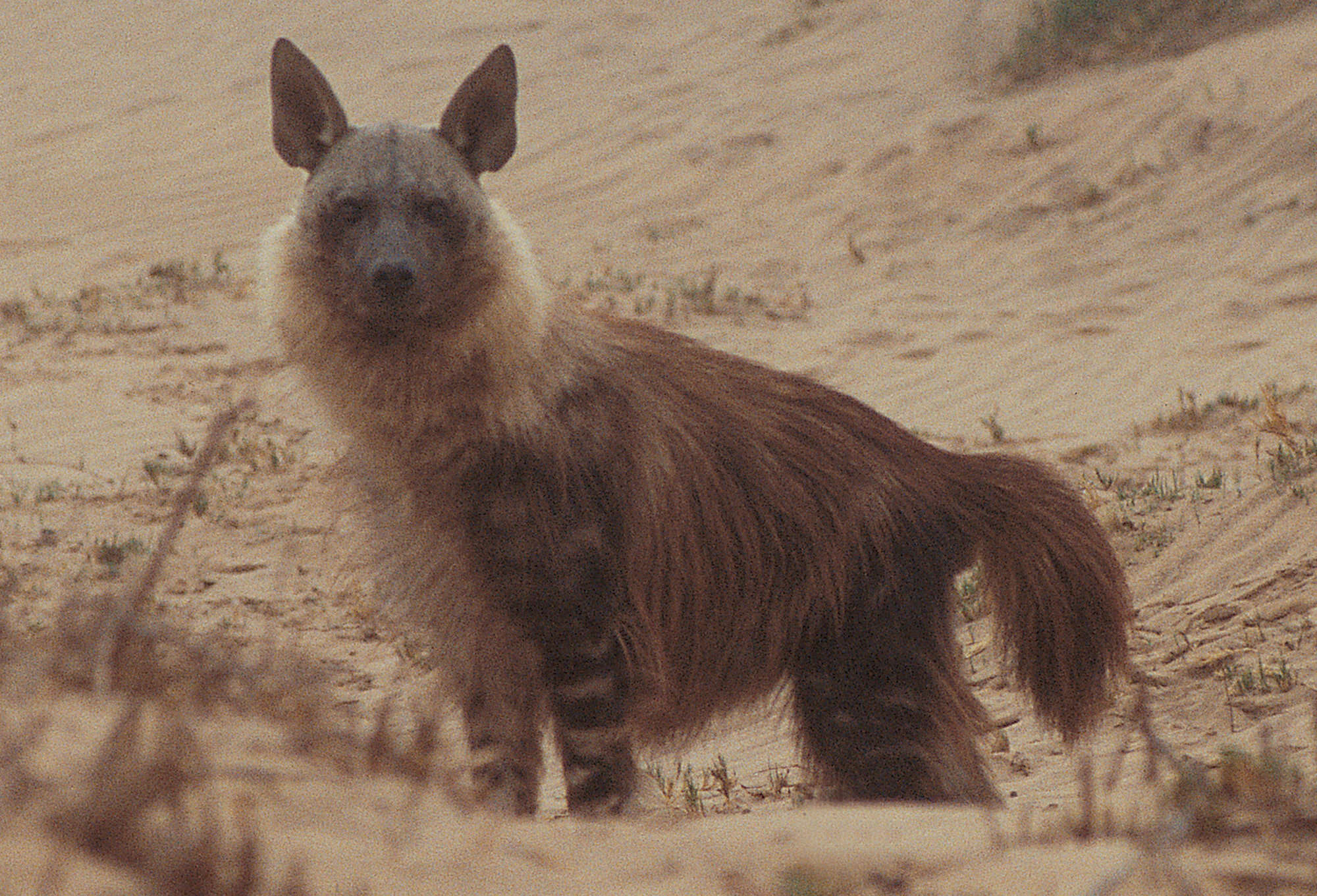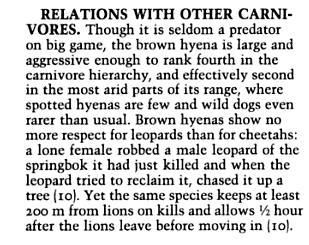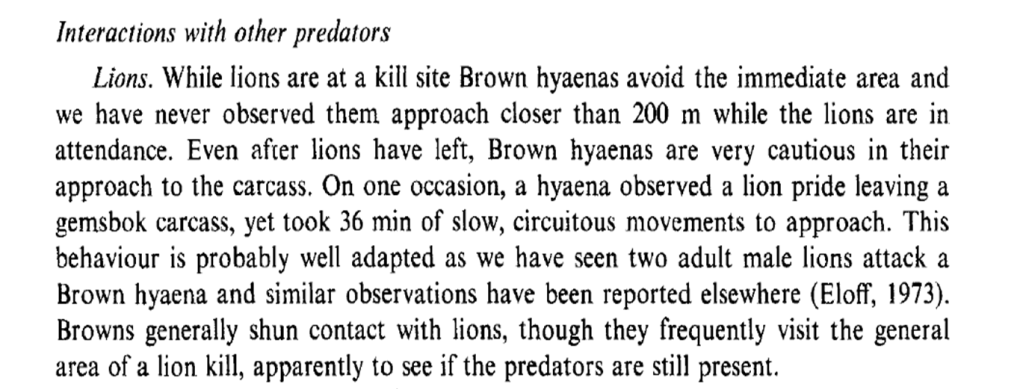Post by Ceratodromeus on Mar 3, 2016 7:39:19 GMT 5

Scientific classification
Kingdom: Animalia
Phylum: Chordata
Subphylum: Vertebrata
Class: Mammalia
Order: Carnivora
Family: Hyaenidae
Subfamily: Hyaeninae
Genus: Hyaena
Species: H. brunnea
Description
The brown hyena is a mid sized carnivoran that is distinguished from other members of the Hyaeninae subfamily by its distinctive, shaggy dark colored coat. The legs are are moderate in length, and the ears are pointed and erect. Sexual dimorphism does not appear to be present in these animals, though there is a large degree of variance in the weights of adult animals. for example, a sample of eleven adult males ranged from 35-43.3kg(77.1-95.4lbs), with a mean of 40.2kg(88.6lbs). In other parts of its range, a sample of 5 adult males documented in northern and southern Transvaal ranged from 38-47.5kg(83.7-104.7lbs) and averaged 43.9kg(96.7lbs){1}. A sample of 8 non-pregnant females ranged from 28-47.5kg(61.1-104.7lbs), with a mean of 37.7(83.1lbs), while a sample of three females taken from Transvaal ranged from 36.3-46.3kg(80-102lbs), with a mean of 40.1kg(88lbs){1}. There is a report of a 67kg(147lbs) female, and large unsexed animals from eastern Transvaal weighing 72.6kg(160lbs) and 59.9kg(132lbs){1}.

Geographic range & diel habits
The brown hyena can be found in be found throughout the southern most parts of Africa, namely arid regions to which it is supremely adapted. They are commonly associated with woodland savannas, open scrubland, and grasslands{3}.They are primarily active during the night, roaming distances of 31-54km(19-33mi) in a single night whilst foraging for food{3}. The brown hyena used to have a much wider distribution than they currently do in Cape Providence, but this has been cut back by the advancement of settlers who feared for their livestock{4}.

Interspecific and intraspecific behaviors
Brown hyenas are largely solitary in nature, but do form small groups. These groups consist of breeding females and non-breeding, related males. These groups do not reach that of the larger spotted hyena, whose clans can number as many as eighty. Brown hyena groups occupy a territory, which cam range from 235-480km2{10}. The borders of which are marked via the anal scent pouch secretions on large stalks of grass{5}. Intraspecific encounters rarely turn violent, and consist of mainly posturing and vocalizations. the submissive animal, for example, an individual intruding on a group's territory, will often signal submission by hunkering low to the ground with its ears laid flat on the head if a territory owner approaches quickly. Another noted trait in intraspecific(and interspecific) encounters is the Brown hyenas' raising of the fur on its back, presumably in a bid to intimidate its adversary.

In areas where the spotted hyena is sympatric with the brown, it is usually the dominant animal -- they have been documented chasing brown hyenas off of food, and are known to chase brown hyenas and kill cubs when they come across one. Brown hyenas have been known to stand their ground against solitary or even pairs of spotted hyenas, but will usually flee when the Spotteds call for clan members to join them{6}.
Lions are known brown hyena killers of varying age groups, and a brown hyena bold enough to encroach on a lion kill pays with its life occasionally. Outside of these circumstances, lions have been observed chasing and killing brown hyenas, like they do with other predators.
brown hyenas are known to steal the kills of leopards, though the prey caching of the cat makes this a rare occurence. Cheetahs quite often give way to a brown hyena trying to usurp their kill, and one well noted event in which a mother cheetah with cubs briefly clashed with a brown hyena before turning and fleeing; the hyena not being dissuaded by the cat's attempt to drive it away{6}. Black backed jackals and the odd caracal have also been documented being chased away from their kills by the brown hyena.

Dietary habits
Brown hyenas have a very wide diet, consisting of vertebrates, invertebrates, and even fruit. Gus Mills has called the observations of groups of brown hyenas bringing down large game in Kruger, citing that his questioning of park rangers produced the conclusion that these officials could not differentiate between spotted and brown hyena spoor, and seemingly confused the species in their observations; stating that spotted hyenas don't kill animals larger than ungulate lambs, and browns took down large prey in groups{6}. Observations on these species suggest the converse is actually true, and observations of the brown hyena's food habits seem to conclude that they eat primarily small animals and carrion, as well as fruit. The jaws of this hyena species are superbly adapted for cracking bones to extract marrow; Carcasses fed upon include those of eland, lion, hartebeest, wildebeest, gemsbok, and springbok{7}. In a study on the diet of brown hyena dietary habits on a game ranch in the Limpopo Province, animals fed upon by brown hyenas included blesbok, blue wildebeest, bushbuck, common duiker, impala, kudu, cape porcupine, and warthog{11}.They have been observed killing and feeding on brown seal pups when they're roaming the Namibian coast{8}. Food killed by the brown hyena is variable, ranging from insects to snakes, lizards, hares and ungulate lambs, also having been observed raiding the nests of ostriches{6}.

Reproduction
During the mating season, female brown hyenas will often occupy a den or burrow crafted by another animal, or one made by themselves, It is typically a nomadic male wandering through a group's territory that mates with the females -- as the males that are in the group are related to the females, this lowers the risk of inbreeding. Mating consists of numerous(many unsuccessful) mountings. A typical gestation period is around 97 days, and a litter ranges from 1-5 pups{3}. They are born blind and without their teeth; the incisors growing in at approximately the fourth week of life{1}. The young will spend most of their time in the innerworkings of the den, which consists of small tunnels in which the cubs can only fit -- an anti-predatory strategy. The remains of baboons, cheetahs, caracals, bat eared foxes, and black backed jackals are commonly found littered around brown hyena denning sites{9}. Brown hyenas attain adult size at approximately 30 months of age, after which they may leave the group in which they were raised in -- becoming the nomadic males, or simply females seeking another group. In captive setting brown hyenas may live 12-15 years, with the odd report of an animal living in excess of 20 years.

References
{1} Mills, M. G. L. "Notes on age determination, growth and measurements of brown hyaenas Hyaena brunnea from the Kalahari Gemsbok National Park." Koedoe 25.1 (1982): 55-61.
{2} Despard Estes, R. "The behavior guide to African mammals. Including hoofed mammals, carnivora, primates." (1991).
{3} Nowak, Ronald M. Walker's mammals of the world. Vol. 1. JHU Press, 1999.
{4} Stuart, C. T., I. A. W. Macdonald, and M. G. L. Mills. "History, current status and conservation of large mammalian predators in Cape Province, Republic of South Africa." Biological Conservation 31.1 (1985): 7-19.
{5} Mills, M. G. L., M. L. Gorman, and Margaret EJ Mills. "The scent marking behaviour of the brown hyaena Hyaena brunnea." South African Journal of Zoology 15.4 (1980): 240-248.
{6} Mills, Gus. , Mills, Margaret. "Hyena Nights & Kalahari Days".
{7} Mills, M. G. L., and Margaret EJ Mills. "The diet of the brown hyaena Hyaena brunnea in the southern Kalahari." Koedoe 21.1 (1978): 125-149.
{8} Kuhn, Brian F., Ingrid Wiesel, and John D. Skinner. "Diet of brown hyaenas (Parahyaena brunnea) on the Namibian coast." Transactions of the Royal Society of South Africa 63.2 (2008): 150-159.
{9} Brain, Charles Kimberlin. The hunters or the hunted?: an introduction to African cave taphonomy. University of Chicago Press, 1983.
{10} Mills, M. G. L. "The mating system of the brown hyaena, Hyaena brunnea in the southern Kalahari." Behavioral Ecology and Sociobiology 10.2 (1982): 131-136.
{11}Burgener, Nicole, and Markus Gusset. "The feeding habits of brown hyaenas (Hyaena brunnea) on a game ranch in Limpopo Province, South Africa." African Zoology 38.1 (2003): 181-184.









